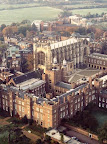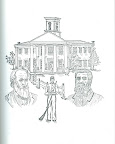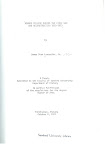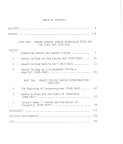
In March, 1910, Hobson Owen Murfee, president of Marion Institute, sent the General Education Board (GEB) in New York City, a 10-page epistle requesting funding for MMI’s endowment. Initially, he hoped to gain some $100,000 from the GEB to establish an endowment foundation for the Institute. A non-sectarian institution, Marion received neither church nor state funding. H. O. Murfee’s dream of creating an “Eton of the South” in Marion was well underway, and Marion Institute (the “military” had been dropped from the name) was fast becoming Marion College, an institution which was initially modeled on Eton College and other great public (private) secondary boarding schools in England, but one which enhanced its secondary nature rather than its collegiate.
Eton College, Windsor. Founded in 1440, additions to Eton’s list of distinguished graduates include Princes William and Harry, both now Old Etonians. (Credit: http://www.ridge.co.uk/sectors_and_projects/education/eton_college.aspx)

The GEB denied Murfee’s request for endowment funding precisely because Marion Institute/Marion College personified a secondary institution and not a collegiate one. Also, funding could only be provided for endowment – present incurred debts (Murfee had some $9,000 in debts already) could not be paid by GEB funding, including the John D. Rockefeller Fund.
Correspondence between Murfee and members of the General Education Board ran for nearly a decade, beginning as early as 1902! Murfee kept trying to convince the GEB that he had amended his original plan, and that he was now transforming the Institute into a full-fledged college, one which would be patterned after the Ivy League colleges and universities. However, MI’s reputation as a strong college preparatory school was difficult to overcome.
Murfee’s 1910 application to the GEB included these statistics as to the number of teachers, students, and graduates since MMI/MI’s founding in 1887, through 1909. (Credit: MMI Archives)

H. O. Murfee canvassed Alabama trying to raise some $100,000 from within the state. The good people of Marion reportedly contributed some $10,000 to this effort, but I have yet to locate a listing of donors. One man from Russellville, Alabama, gave $5,000 in the name of his late son, who was a MI student.
In short, H. O. Murfee’s dream was well underway, but his plans to expand and improve the physical plant alone were incurring numerous debts. The long sought-after monies for the endowment – vital to insure the stability of Marion College – was just not forthcoming in the amounts needed to stabilize the institution.
In the end, the outbreak of World War I, mobilization, and the return to military training at the Institute, signaled the demise of H. O. Murfee’s dream of an “Eton of the South.” After so many years of hard work and sacrifice pursuing his goal, Hobson Owen Murfee must have been crushed by its failure.


